COVER- I [heart] Charlottesville: Is our town the new Little Apple?

Dine at Ten, catch Whoopi Goldberg at the Paramount, and cap the night at a trendy new martini bar called the X-Lounge. The next morning, take a class in Bikram Yoga, visit the Miller Center for a talk by Senator Ted Kennedy or George McGovern, finish up with dinner at one of the area's four-star restaurants.
Culture, culture, culture, fine dining, and diversity. Some say it's the best of times for Charlottesville.
But then there's the ceaseless development, high real estate prices, and what many consider the loss of our small town appeal. Maybe it's the worst of times...
It's certainly a bad time for a Republican Senator who used to represent Albemarle in the General Asseembly and Congress.
Is Charlottesville New Yorkifying? Can it be long before we call ourselves the "Little Apple"? Any way you slice it, the issue is ripe for debate. A few signs...
Albemarle goes Dem
Has Albemarle County adopted a New York state of mind? A look at county politics over the last 13 years shows the once-powerful Republican stronghold moving steadily to the left. In six of the last eight elections, Albemarle has joined Charlottesville in the wild blue yonder. (County residents voted for President George Bush by a 5.5 percent margin in 2000, and for Senator John Warner in 2002 when he faced no Democratic opponent.)
There may be no better example of the county's political shift than recently defeated U.S. Senator George Allen. When Allen ran for Governor in 1993, 60 percent of county voters marked their ballots to help him defeat Democratic opponent Mary Sue Terry. But it's been downhill in Albemarle for him and other Republicans ever since (see graph).
When Allen won election to the U.S. Senate in 2000 with 52 percent of the statewide vote, Albemarle gave him thumbs down– 48 percent of the votes. In this year's Senate election, Allen's Albemarle take shrank to just 44 percent. What gives?
"University communities tend to be heavily blue localities," says UVA pundit Larry Sabato, who accurately predicted 96 percent of the nearly 500 recent races including challenger Jim Webb's defeat of Allen. "UVA has expanded its reach into Albemarle County," he says, "and this part of the Piedmont has turned a bright blue."
Sabato explains that college towns are liberal because of the high percentage of residents with graduate degrees. As the school expands, so it seems does the blue.
"Growth is helping to fuel this political change in Albemarle County," says Albemarle Democratic Party chair Fred Hudson.
Albemarle GOP chair Keith Drake agrees that growth is helping the Dems. He says it's the type of people moving here– particularly liberal retirees from the northeast– who have helped shift the voter demographic.
"There are a lot of folks from New York and New Jersey heading to Florida," Drake says, "and they run out of gas here."
New York state of mind, indeed.
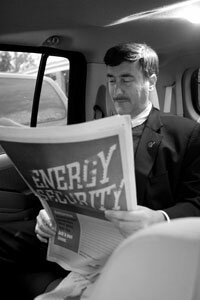
Larry Sabato says this area is "bright blue."
PHOTO BY WILL WALKER
From here to there
One need look only at the transportation options to and from New York to realize there's a vital link between the two cities. Every weekday offers three direct nonstop flights from Charlottesville Albemarle Airport to New York's LaGuardia– two on Saturday and Sunday. That makes New York the number-one "terminal destination" for travelers leaving Charlottesville, says airport spokesperson Terrie Dean. Amtrak also offers daily direct Charlottesville-to-Penn Station trips on "The Crescent."
Another popular way to get to Broadway: the Starlight Express. Launched in 2004, the fleet of luxury buses has grown from one 22-seater to four, and Starlight Express manager Tom Macon says business is booming for the $159 round-trip service, with one segment growing faster than any other: trips originating in the Big Apple, bringing New Yorkers to Charlottesville. Some of those trips, says Macon, are one-way. You do the math...
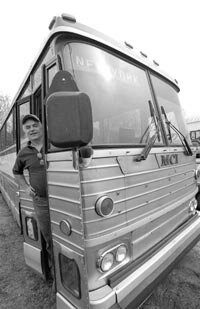
Starlight Express co-owner David New with the bus that started it all.
FILE PHOTO BY JEN FARIELLO
Gay friendly
Election day may have been a dark one for homosexuals in the Old Dominion when Virginians approved a consitutional amendment reiterating already existing law defining marriage as a union of one man and one woman. But here in Charlottesville– where voters rejected the amendment by the largest margin in the state, by nearly 80 percent– there was at least some reason for gays and lesbians to feel supported.
"It's nice living in a community like this," says Mark Usry, a board member of Equality Virginia, a Gay and Lesbian nonprofit. He says local schools and governments in both Charlottesville and Albemarle respect gay rights. "We really couldn't ask for more," he says.
The east end of the Downtown Mall may never be the East Village, but Charlottesville is increasingly a place where gays and lesbians can be themselves. A website, gaycville.com, launched in 2005 to serve as a "portal" for gays and lesbians to connect for social activities and events, according to founder Kristi Lombard. And then there's Club 216. The late-night club proves– if nothing else– that people get along at 3am when it's the only party scene in town. On a typical weekend night, 216 gradually transforms from a primarily gay scene to one where tobacco-chewing good old boys, rappers, and a few transvestites amiably commingle.
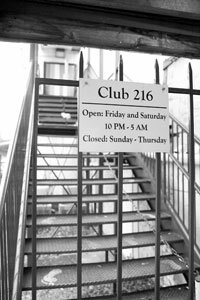
Club 216 plays host to all types in the wee hours.
PHOTO BY WILL WALKER
Where there's no smoking...
Dining options in Charlottesville run the gamut from down-home dives to French finery. While prices don't yet match New York's, diners can order the cuisine of almost any land. But international fare isn't the only Big Apple-esque element of the dining scene. If a slew of the new restaurants opening downtown are any clue, Charlottesville restaurateurs are moving in a New York direction by voluntarily banning smoking. Unlike New York City, which passed a stringent law regarding smoking in restaurants in 2003, Charlottesville government– although monopolized by Democrats– is taking a laissez-faire approach and letting the market decide.
Fleurie and Zocalo opted for non-smoking policies from the moment they opened in 2003. This past summer, X-Lounge followed suit. Although he allowed smoking on its first night, owner J.F. Legault says that by night two it was verboten.
"You could really smell it the next morning," he says.
Now come two more downtown nonsmoking establishments: Ten, a sleek sushi bar that opened Halloween night above Blue Light Grill, and Boheme, which owner Tom Fussell describes as "Bourbon Street in 1895."
Fussell says the decision was simple. "The place is just too small for smoking," he says, so he and chef Clive Papayanis have worked to create a comfortable smoking area outside. Fussell says he can also see the writing on the wall.
"The Department of Health is probably going to pass a law about smoking in restaurants in the next couple of years," he says, "and we wanted to be ahead of the curve."
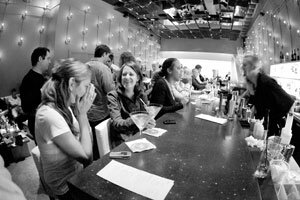
Nothing says New York like no smoking. Ten sushi bar opened on Halloween.
PHOTO BY WILL WALKER
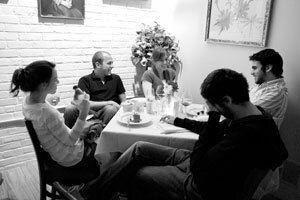
Diners enjoy fine cuisine at Boheme
PHOTO BY WILL WALKER
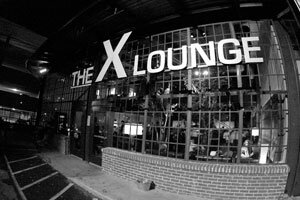
Take it outside at the X Lounge– your bad habit, that is.
PHOTO BY WILL WALKER
Give us your tired, your poor, your huddled masses...
Apparently, Lady Liberty is directing the masses south. Anyone who spends a few hours observing passersby on the Downtown Mall can see that Charlottesville is now home to people who might once have been seen only in larger cities like New York. While UVA certainly draws international students and staff, this area's increasing diversity is thanks in no small part to the efforts of the International Rescue Committee, which has been resettling refugees in Charlottesville since 1998.
Committee director Susan Donovan says the goal is to bring in 150 refugees each year. The Committee assists the newcomers in assimilating, helping adults find work and homes, and helping children adapt to school. Among the countries of origin of Charlottesville refugees: Bosnia, Afghanistan, and, most recently, Somalia.
Although 130 Somali Bantus came to Charlottesville in 2004, about half have resettled in the more arid climate in the west, she says. But the approximately 65 who remain in Charlottesville are thriving, says Donovan, who delights in the fact that one Bantu family will soon own their own home through Habitat for Humanity.
"When they got here, they'd never seen a lightbulb," she says. "Now they're going to be homeowners."
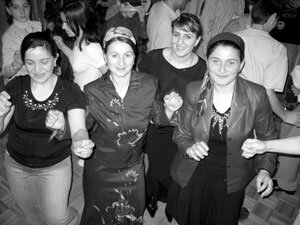
Refugees from Turkey dance at a party in Charlottesville.
PHOTO COURTESY IRC
Puttin' on the Ritz
Who needs Madison Avenue when there's the Downtown Mall? Over the last decade, the Mall and surrounding blocks have welcomed upscale boutiques such as women's clothing purveyors Eloise, Chloe, and Georgie, as well as numerous gift and trinket shops. But nothing shows the trend toward New York exclusivity like stationery and paper goods store Caspari, which warms the hearts of the Charlottesville-centric who notice that it has headquarters in New York, but stores in just two locations: Paris, and– yes– Charlottesville.
We're playing with the big kids, now!
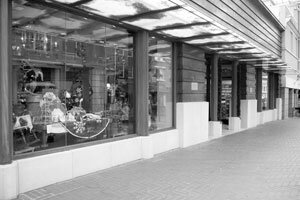
"New York, Paris, Charlottesville."
PHOTO BY WILL WALKER
Celebrity-ville
Gwyneth and Sarah Jessica may have picked New York's pricey pads to hang their hats, but Albemarle beckoned Sissy and Howie! These movers and shakers could plunk down a bundle to live anywhere they want, yet here they are on the red clay soil of Central Virginia. Joining Spacek and Long as C'ville's celebrity residents: best-selling author and baseball fan John Grisham, director Hugh Wilson, and that other guy. What's his name? Dave... Dave something? Oh, yeah, you mean that guy who bartended at Miller's?
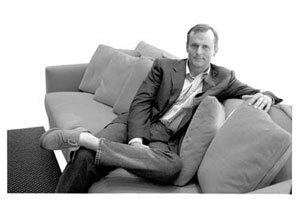
Grisham picks Charlottesville.
FILE PHOTO BY JEN FARIELLO
Genitals, murders, and sex, oh my!
Nothing says New York like edgy art, and Charlottesville– for a small city– offers its share of "challenging" art and live performances. Take the October art exhibit at UVA's Off Grounds Gallery, which featured UVA artist-in-residence Ebony Patterson's interpretations of the vulva.
And Live Arts has long provided controversial stage pieces with nary a protester in sight– including a musical called Urinetown. In February, they'll offer The Pillowman, a play about an author who writes about the violent deaths of children.
Live Arts executive director John Gibson says Live Arts has long done work "that's meant for a sophisticated audience," and that "asks people to step outside their comfort zone."
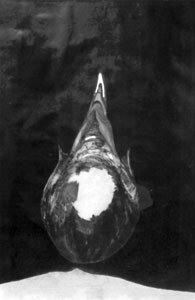
Ebony Patterson's artistic renderings of vulvas showed at the Off Grounds Gallery in October.
Festivals galore
New York may be the festival capital of the world, but Charlottesville has steadily increased its reputation for world-class festivities like the Virginia Festival of the Book and the Virginia Film Festival. Every year, authors and auteurs descend on the city, drawing thousands of fans and fawning groupies from around the country.
In March, they pore over pages of every type of book imaginable, while authors like Malcolm Gladwell and Tony Horwitz give readings and discuss their works.
In October, Charlottesville is the place for premieres– this year, Little Children was a big hit at the Virginia Film Festival after wowing festival crowds in Telluride, Toronto, and yes, New York.
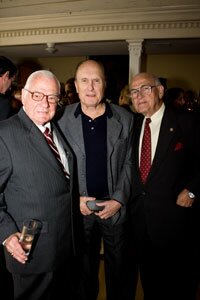
Warrentonian Robert Duvall (at the film fest's opening night gala) added star power to this year's festival.
FILE PHOTO BY WILL WALKER
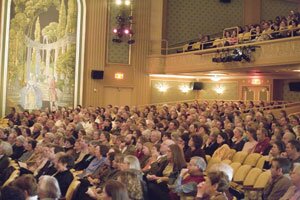
Crowds fill auditoriums for the Virginia Festival of the Book.
Condo craze
Charlottesville has a long way to go before it can say it's competing with New York real estate prices, but the recent condo craze spawned a few places so luxurious– and so expensive– that it seems impossible they aren't in mid-town Manhattan. Take the Holsinger, built in 2005 on Water Street next to the C&O restaurant. Several of the larger penthouse units sold for over $1 million last year, while smaller units in the building easily topped half a million– and that's not counting monthly condo fees.

Million dollar condos have arrived.
PHOTO BY WILL WALKER
The Coran
New York has the Donald. Charlottesville has the Coran. Indeed, if there's one person in town who's singlehandedly driving urbanization, it may be Dave Matthews Band manager Coran Capshaw, who keeps the Charlottesville/New York connection alive in seemingly countless ways: ATO Records, the music label Capshaw co-founded with Dave Matthews, has offices in Crozet and... New York. Other Capshaw projects include music venues Starr Hill and the Charlottesville Pavilion, which regularly bring acts once considered too big for our a little central-Virginia burg. And he's currently at work modernizing the Jefferson Theater to be yet another music mecca.
Capshaw's real estate empire stretches from the Downtown Mall to an 89-acre parcel off Fifth Street Extended and out to Crozet again. And his restaurants bespeak a certain urban, New York-ish, vibe: Blue Light Grill, Mas tapas bar, Mono Loco, and now the sushi bar named Ten make no secret of the fact that, in the Coran's eyes, nothing's too chic for Charlottesville.
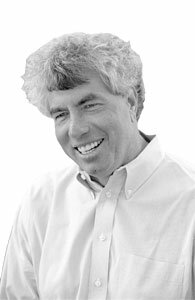
The Coran is to Charlottesville as the Donald is to New York.
PHOTO BY WILL WALKER
Sidebar: Not New York: Gibson says give it up
New York, Schmoo York! Charlottesville isn't the Big Apple, the little apple, not even a crab apple, according to longtime resident John Gibson, who objects to the tendency to compare Charlottesville to any other place, but particularly to a big city.
"The urban experience as I know it," says Gibson, "has to do with a variety of cultures and ethnicities coexisting."
Although that variety has increased locally, Charlottesville has a long way to go before we'll be urban by that definition, says Gibson, the artistic director at Live Arts, a theatrical company.
Gibson pins his hopes for diversity on two entities: UVA and the International Rescue Committee, the former which grows each year and the latter which brings in 150 refugees from around the globe each year.
Another reason Charlottesville isn't truly urban: "a lack of true economic diversity," he says, because the poor are being systematically pushed out of town by rising real estate costs.
The result, says Gibson, is that the people who are left are "very affluent," and that universal affluence harms the city in subtle ways. Great art, for instance, often comes from the suffering poor class intermingling with those of great wealth.
But that's not happening here.
"There seems to be little of the discomfort that comes from wildly variant classes rubbing up against one another," he says.
Gibson's certainly not wishing poverty on anyone; he's simply pointing out the ways in which he believes Charlottesville is not– and will never be– like New York.
That said, Gibson admits there's nowhere he'd rather live, and he sings the praises of all that Charlottesville does offer– from cultural events to shopping to natural beauty and history.
"No, we're not an urban center, but what a great alternative we are," he says. "Can we not be content being a little town with all of these wildly wonderful amenities? Why do we have to model ourselves on New York? Why can't we be a village with an atittude that's not metropolitan but cosmopolitan.
"Let's not look to the cities for a model, let's look to the world as a model."
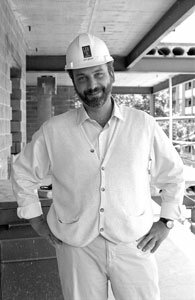
John Gibson sees affluenza (but he doesn't call it that)
FILE PHOTO BY JEN FARIELLO
#